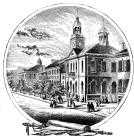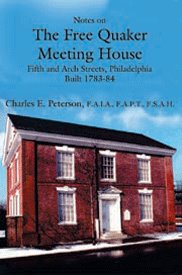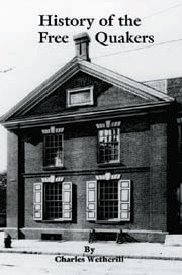Related Topics
Religious Philadelphia
William Penn wanted a colony with religious freedom. A considerable number, if not the majority, of American religious denominations were founded in this city. The main misconception about religious Philadelphia is that it is Quaker-dominated. But the broader misconception is that it is not Quaker-dominated.
Quakers: The Society of Friends
According to an old Quaker joke, the Holy Trinity consists of the fatherhood of God, the brotherhood of man, and the neighborhood of Philadelphia.
Particular Sights to See:Center City
Taxi drivers tell tourists that Center City is a "shining city on a hill". During the Industrial Era, the city almost urbanized out to the county line, and then retreated. Right now, the urban center is surrounded by a semi-deserted ring of former factories.
Quakers: All Alike, All Different
Quaker doctrines emerge from the stories they tell about each other.
Revolutionary Philadelphia's Patriots
All kinds of people were patriots in 1776, and many of them were all mixed up about what was going on and how they stood. Hotheads in the London Coffee House stirred up about an inoffensive Tea Act, Scotch-Irish come here to escape the British Crown, the local artisan class and the local smuggler class, unexpectedly prospering under non-importation, and the local gentry -- offended to be denied seats in Parliament like other Englishmen. Pennsylvania wavered until Ben Franklin stepped forward with a plan.
Tourist Walk in Olde Philadelphia
Colonial Philadelphia can be seen in a hard day's walk, if you stick to the center of town.
Arch Street: from Sixth to Second
When the large meeting house at Fourth and Arch was built, many Quakers moved their houses to the area. At that time, "North of Market" implied the Quaker region of town.
Quaker Peace Testimony
New topic 2016-12-04 04:05:49 description
Free Quaker Meetinghouse

|
| Independence Hall |
Until this year, there was a Beautiful Mall stretching north from the State House (Independence Hall) to the approaches of the Benjamin Franklin Bridge. Concealing an enormous parking garage underneath it, the surface looked like a several-block lawn lined with flowering trees in the spring, framing the beautiful Eighteenth Century building (just as the mall in Washington leads up to the Washington Monument.)
Stretching from Independence Hall east to the Delaware River is another mall filled with historical buildings like Carpenters Hall , the First Bank(Girard's) and Second Bank (Biddle's), the Old and the New Custom houses, the American Philosophical Society, and others. The eastern mall was the property of the State of Pennsylvania when it was created, but it soon seemed more economical to the frugal rural legislature to turn it over to the federally funded National Park Service, joining the mall stretching northward. Well, somebody got another ton of federal money appropriated, and now we are filling the north mall with buildings which largely hide Independence Hall from the passersby. With just a few more Congressional earmarks, the imposing beauty of the mall will be submerged, but it hasn't quite reached that point yet. There is a perfectly enormous New Visitors Center, containing a couple of auditoriums and a big bookstore. Mostly the concept seems to be to provide a place to get out of the rain if you are an out of town visitor, provide public bathrooms, and a place to get a hot dog. At least the visitors center is red brick, and arched, with white woodwork. At the far northern end is an overwhelming stark granite block of a building, which will open July 4, 2003. It is a Constitution Center, claimed to be an interactive museum, and we shall see what we shall see. The looming monolith overwhelms and blocks the view to Independence Hall, and it better be good, when the insides get finished.

|
| Free Quaker Meeting |
If Independence Hall, which after all is a block long, is overwhelmed by the new constructions, the Free Quaker Meeting is totally hidden. This perfectly charming Eighteenths Century Quaker meetinghouse is just across Fifth Street from Benjamin Franklin's Grave, and just across Arch Street from the Constitution thing, completely in its shadow. Charles E. Peterson designed the restoration of the building, which had been added to and detracted from, over the years, but you can be sure its interior is now both beautiful and authentic. Before you go in, notice the inscription on the plaque under the northern eaves:
By General Subscription for the FREE QUAKERS. Erected in the Year of OUR LORD 1783 and of the EMPIRE 8.
The Quakers who built this building seem to have thought they were part of a new empire, but that implies an emperor, and of course, one was never created. Three years after the dedication of this building the Constitutional Convention met in the same Independence Hall, and our national form of government was somewhat strengthened from the Articles of Confederation also written here. Benjamin Franklin had a hand in both documents, but the first one was mainly composed by John Dickinson, and the second one by James Madison. If you go into the Free Quaker building, it seems to be a single large room with an interior balcony, and a couple of small staircases in the back leading down to what would presumably be restrooms. As a matter of fact, the Park Service extended the basement to include kitchen and dining room, and several offices for themselves which are a surprise if you are allowed to go down to see them.

|
| History of Free Quakers |
Charlie Peterson wrote a book about the restoration, but the main book about the spiritual history of this group was written by Charles Wetherill. Quakers, as everyone ought to know, are pacifists. The American Revolution put a number of them in a quandary because they agreed that Great Britain was injuring their rights by denying them a representative in the Parliament which ruled them but resorting to violence was another matter entirely. Eventually, a group did break away from the main Quaker church to fight for independence. They were prompt "readout of the meeting", the equivalent of being excommunicated, not allowed to worship in the regular meeting houses they had helped finance or to be buried in the church graveyards. Samuel Wetherill was one of the leaders of this group, just as his descendants are the most active today in the surviving historical society. Samuel created quite a furor, demanding to use the Orthodox meeting house and burial grounds. He was, in his own view, just as much a Quaker as the others since no doctrine is absolutely fixed in that religion, and was freely entitled to speak his mind to persuade others of the rightness of his sincere positions. The main body of Quakers would have none of it, and the Free Quakers were firmly expelled, forced to hold a public subscription and build their own meeting house. Wetherill of course personally knew every one of the members who expelled him, and there may be some truth to his loud, pointed and unchallenged contention that the true division was not between pacifists and fighters, but between Tories and advocates of Independence. Whatever the truth of these accusations, it does seem in retrospect that the split was fairly divided between wealthy established merchants, and small shopkeepers and artisans. Quite a few now-famous names appear on the rolls of the Free Quakers, like Timothy Matlack the actual Scribe of the Declaration of Independence document, Biddles, Lippincott, John Bartram,Crispins, Kembles, Trippes, and Wetherills. When the meeting had dwindled down in 1830 to two lone parishioners, one was a Wetherill, and the other was Betsy Ross, herself.
A comment is submitted by a reader:
I think your description of the Free Quakers oversimplifies their origins. It is true that Samuel Wetherill was disowned by Friends for his military activities. However, other Free Quaker leaders were bounced -- often years before the Revolution -- for other reasons. Timothy Matlack, for not paying his debts. Betsy Ross, for an improper marriage. Christopher Marshall, for counterfeiting. I haven't traced everyone listed as a member in the (1907?) Stackhouse history of the Free Quakers. But I did search in Quaker records for perhaps a dozen and found no records that people with those names had ever been Quakers. I think it would be more accurate to say of the Free Quakers that the Revolution drew together people of many different types and that when some of those people had things in common -- such as Quaker background -- they united around those things. (Posted by Mark E. Dixon )
Originally published: Monday, June 26, 2006; most-recently modified: Monday, May 20, 2019
| Posted by: dan ulmer | Nov 11, 2012 8:45 PM |
| Posted by: Alif | Feb 13, 2012 11:50 PM |
| Posted by: leggs | Dec 2, 2010 4:32 PM |
Quite a few now-famous names appear on the rolls of the Free Quakers, like Timothy Matlack the actual Scribe of the Declaration of Independence document, Biddles, Lippincott, John Bartrum, Crispins, Kembles, Trippes, and Wetherills. When the meeting had dwindled down in 1830 to two lone parishioners, one was a Wetherill, and the other was Betsy Ross, herself.
| Posted by: George William Bartram | Aug 12, 2010 3:37 PM |
| Posted by: Mark E. Dixon | Feb 26, 2010 1:33 PM |
| Posted by: Chris | Sep 4, 2008 2:29 PM |
2. The Free Quaker burial ground was five or six blocks South of the meeting house, but was moved to Audubon PA. Ethan Allen's brother was shipped back to Vermont at that time.
| Posted by: George Fisher | Jul 23, 2007 5:31 PM |
| Posted by: J. Roach | Jul 12, 2007 10:31 PM |
| Posted by: Dr. Fisher replies | May 22, 2006 8:26 AM |
| Posted by: Miriam | May 19, 2006 11:53 AM |